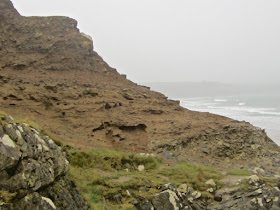Fifty years ago I produced the above diagram for the drift stratigraphy at Trwyn Hwrddyn headland, in the northern part of Whitesands Bay. It was a pretty accurate representation of what was visible at the time -- but there have now been substantial changes, and I no longer think that there are two till layers here, separated by a sandy and gravelly layer. I think layers 2, 3 and 4 are all parts of the same glacial sequence, probably relating to the Devensian glacial episode.
So let's explore what can be seen in the "northern" drift cliff exposures, just to the north of the archaeological site referred to as "St Patrick's Chapel".
The St Patricks Chapel dig in 2015. The Quaternary cliff exposures extend northwards from the cliff seen at bottom left.
In this area there are a few small remnants of raised beach platforms, but they are very much broken up. There are at present no traces of the raised beach, but the lowest deposits exposed are brecciated slope deposits made of local shales and mudstones, up to 1m thick. Above these there is a suite of glacial deposits of varying lithologies -- including typical clay-rich Irish Sea till, sandy and gravelly meltout till and flowtill with signs of layering.
Brecciated slope deposits with rough stratification, resting on broken bedrock. Above it, 3m - 4m of "rubble drift" very similar to that at Abermawr. The deposit has a sandy and gravelly matrix, and there are many included igneous erratics.
The "rubble drift" at Whitesands North, here devoid of stratification. This is best interpreted as a meltout till, subject to a degree of remobilisation during ice wastage.
Here there is a degree of stratification -- or at least pseudo-stratification. There are many local sharp-edged fragments in this deposit, but I suspect that it was laid down as a highly mobile flowtill rather than as a periglacial deposit following deglaciation.
Clay-rich Irish Sea till resting directly on bedrock. It is full of igneous erratics and also many sharp-edged or sub-angular fragments of local sandstone and shale -- suggesting the incorporation of old periglacialor brecciated slope deposits by overriding ice.
Striated igneous boulder embedded in the Irish Sea till at Whitesands North.
Clay-rich Irish Sea Till on the neck of the Trwyn Hwrddyn Headland. Here there are signs of glaciotectonic structures including shearing. (This is very similar to the "Scilly Till" at Bread and Cheese Cove, St Martins, and Chad Girt, on White Island, in the Isles of Scilly.)
There are no obvious glaciofluvial deposits at this site, but on the neck of the headland the upper part of the glacial sequence is more sandy and gravelly, with much clearer signs of stratification. This is shown in the photo below.
We can also see in this photograph traces of a cap of brecciated slope deposits on the glacial deposits, at the top of the cliff. There is one unusual occurrence in the sequence -- namely a "lens: of slope breccia contained within the glacial deposits. This suggests either (a) that there was an exposed bedrock crag in the vicinity during deglaciation, contributing occasional rockfall debris into the dead ice / ice wastage mix of deposits. or (b) that overriding ice dragged away a frozen slab of scree and incorporated it into the till layer.
A lens of broken shale fragments within the glacial sequence in the neck of the headland. This possibly suggests a localised rockfall from an exposed bedrock crag.
Above the upper brecciated slope deposit there is a thin layer of blown sand and surface soil -- this ties in with the sand dunes in other parts of the bay.
The full sequence in the northern part of the bay is therefore as follows:
6. Modern soil
5. Blown sand -- here up to 20 cm thick
4. Upper stratified and brecciated slope deposit -- periglacial inn origin? Up to 50 cm thick
3. Irish Sea till -- upper facies with sandy and gravelly matrix -- meltout till and flowtill? Up to 4m thick
2. Irish Sea till -- lower facies, massive clay-rich till with some glaciotectonic structures -- up to 2m thick
1. Lower brecciated slope deposits -- up to 1m thick. Periglacial phase?
I'll do another post pulling together the full Whitesands sequence.
I'll do another post pulling together the full Whitesands sequence.










No comments:
Post a Comment
Please leave your message here